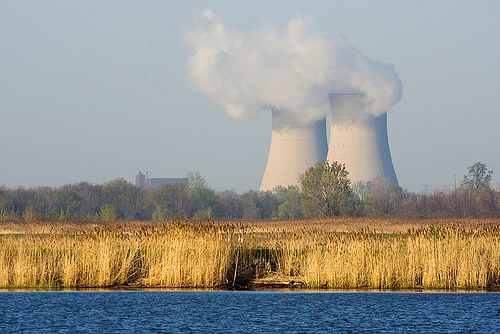The Obama administration on Tuesday announced a loan guarantee for the first new nuclear reactor to be built in the US in decades—part of a planned $54.5 billion program to kickstart a nuclear revival using government-backed loans. Yet Chu said he was not aware of a Congressional Budget Office study showing that the chances of default on these loans are “very high—well above 50 percent.”
“I don’t know of the CBO report,” Chu told reporters during a conference call on Tuesday. “We don’t believe the chance of default is 50 percent. We believe it’s far less than that.” The first loan guarantee, worth $8.33 billion, was awarded to two proposed reactors to be built by Southern Company at Plant Vogtle in Burke, Georgia.
As Mother Jones has reported, the proposal to encourage nuclear construction via massive federally backed loans represents a major risk for the US taxpayer. While the nuclear industry as recently as 2005 claimed the price tag for a reactor was $2 billion, independent estimates now put the cost as high as $12 billion.
In fact, the economics of the nuclear industry look so dicey that Wall Street banks—no strangers to high-risk investments—have for several years balked at financing new plants unless the government underwrites the deal. “There will be no nuclear renaissance beyond what the government is willing to underwrite,” Peter Bradford, a former member of the Nuclear Regulatory Commission who is now a professor at Vermont Law School, told Mariah Blake in a recent piece for Mother Jones. And the nuclear industry has not been shy about announcing its reliance on the taxpayer. “Without loan guarantees we will not build nuclear power plants,” Michael J. Wallace, co-chief executive of UniStar Nuclear and vice president of Constellation Energy, told the New York Times in 2007. That means the government would assume almost all the risk.
“Even Wall Street traders say these reactors are too risky to invest in, and that tells you something,” said Ben Schreiber, climate and energy tax analyst for Friends of the Earth. “There’s a 50 percent or greater risk of default. Why should taxpayers bear that risk?”
UPDATE: Stephanie Mueller, Press Secretary for the Department of Energy, sent this response on Tuesday evening: “This is a 7 year old analysis of legislation that was never enacted, and it is not germane to the current project—which has undergone rigorous financial analysis, is conditioned on regulatory approval, uses proven technology, and sets strict financial requirements to protect taxpayers. Further, the project already has power purchasing agreements in place. In other words, utilities have signed contracts agreeing to buy power from the plant for many years into the future, ensuring a stream of revenue.”
That the study is dated is fair criticism, and the CBO is expected to issue an updated study on loan guarantees sometime soon. But the program the study examined in 2003 is not much different from the one the Obama administration is currently in the process of expanding. The CBO at that time estimated that loan gaurantees would cover half the construction cost of a new plant—the current proposals would cover up to 80 percent. And while it’s beneficial that the Georgia project already has a power-purchasing agreement in place, the recent debacle with the proposed nuclear plant in San Antonio demonstrates that those agreements are hardly fail safe.














